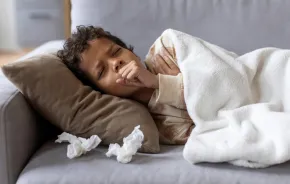
Editor’s note: This article was sponsored by Seattle Children's Hospital.
When pediatric psychologist Gary Walco works with children who are scared of needles, he considers what is driving their fear.
“You need to understand why they find it difficult,” said Walco, the director of pain medicine at Seattle Children’s Hospital. “What about it is so troubling?”
Understanding the child’s perspective can help guide strategies, ranging from educating them about the procedure to creating a distraction plan. Addressing these fears and reducing the resulting stress is crucial: Even one negative experience can lead to “pain memories” and healthcare avoidance. On the other hand, developing coping skills at an early age can improve children’s healthcare interactions for their entire life.
“If you then do things to make the situation more anxiety provoking, it’s not shocking it will lead to avoidance,” Walco said. “We should be doing everything we can to make medical visits as low anxiety as possible.”
Customizing the response
For many children, distress around needles stems from the combination of the pain itself plus the anxiety associated with it. The interplay can compound the negative effect.
“When you have a child worked-up about vaccinations, they become more sensitive to pain,” Walco explained. For immunizations, numbing cream for the skin (over-the-counter or prescribed) can alleviate pain and reduce a child’s pain-related distress.
In an effort to combat needle fears from an early age, Seattle Children’s will be piloting a new program in its Odessa Brown Children’s Clinic. Patients requiring a needle will be offered topical anesthesia for the injection site as well as guided coping strategies. The ultimate goal is that every child’s needle experience involves as little distress as possible.
Providers will work with the child during the visit to help them cope with needles in a way that best suits their temperament and needs. For some young patients, this may involve distraction via party blowers, videos or books. Other children might prefer “mastery”: understanding the procedure and the mechanisms involved.
In Walco’s own practice, he has long utilized these kinds of approaches. For some fearful young patients, he will offer to let them hold and examine a capped needle, as part of desensitization.
“They realize it’s barely thicker than a hair, which can be calming,” he said. “They have this fear of these big needles going in. Sometimes when they see how small they are, it’s helpful.”
Others might be more concerned with the idea of a foreign body entering their body. In these cases, he might show them a diagram of the muscle, explaining why the upper arm tissue is a good spot for a vaccination.
Still some children might want nothing to do with science, preferring to be anywhere else but the exam room. In these cases, distraction is the best approach.
Parents play a key role
There are several steps a parent can take to help their child with vaccination and other needle-related procedures. But, before addressing your child’s anxieties, it’s important for caregivers to consider their own feelings and how they cope.
“If a parent is anxious about the whole situation, that’s going to be something that impacts the child,” Walco said. “If a parent is trying to distract a child, and a child wants to master the situation, that’s a bad match.”
If you’re unsure of which strategy fits your child, you can ask them to imagine their preference. For example: “Would you rather cover your eyes and not look when the needle goes in? Or do you prefer to watch and understand what’s happening?”
Preferences can be detailed in a written plan before the visit.
For a child who likes to learn about a procedure, a parent could narrate what’s happening with sensory descriptions, such as what the child is seeing, feeling or smelling at each step. Some children might respond well to getting involved, perhaps counting down before the injection and placing the bandage on afterward. Still others might prefer to experience a distraction from the needle. In this case, the parent might want to bring a book, sing a song, or show a video that can get their mind off the needle.
For young children, holding them in a comfortable position while gently stroking their hair or softly singing can help relieve anxiety. For infants, a parent could breastfeed during the process or offer sucrose on a pacifier. Older children might choose to “blow away the pain,” utilizing deep breaths that also create a sense of calm.
Once the healthcare visit is completed, it’s okay to offer your child a treat, Walco said. At the same time, it’s important to be mindful of how you frame the experience. Include the treat as part of the whole experience compared to a reward/punishment for specific behaviors during the visit.
“The situation that gets sticky is withholding a reward, and punishing a child who is already struggling,” Walco said. “That’s dicey.”
Avoid these missteps
As you prepare your child for the experience there are some pitfalls to avoid, such as apologizing to a child for a medical procedure. While it might feel well-intentioned, this only contributes to the sense of powerlessness, Walco said.
“You’re reinforcing the idea of helplessness: Even my mother and father who are all-powerful are apologizing and can’t help me,” he said.
Another common misstep: The sense that enduring pain is a virtue that everyone must overcome. This means, no comments about “Be a big boy/girl,” or dismissing the experience with a “this won’t hurt.”
If a child is kicking and screaming in resistance, the response should never be to pin them down against their will. Overpowering someone only reinforces their aversion, he said.
To help with all of these situations, Seattle Children’s developed a flow chart that guides children and parents alike to map out their strategies and approaches. With some advance planning and coping strategies, the visit itself can be less stressful for everyone involved.
When additional support is needed
Even when the best attempts at coping, distraction and pain mitigation are used, some children continue to experience significant needle fears that can get in the way of getting timely vaccinations or other medical care. For those youth, working with a pediatric psychologist using behavioral strategies to face their fears may be helpful.
Seattle Children’s Hospital offers a Coping with Needles and Pokes group treatment, developed by pediatric psychologists Joy Kawamura and Joanna Patten, to help children and their parents learn strategies to get through needle procedures such as vaccinations and blood draws. With repeated practice, children gain more confidence in their ability to get through needle procedures, even when they feel worried, and they feel incredibly accomplished when they do.
|
Sponsored by: |












